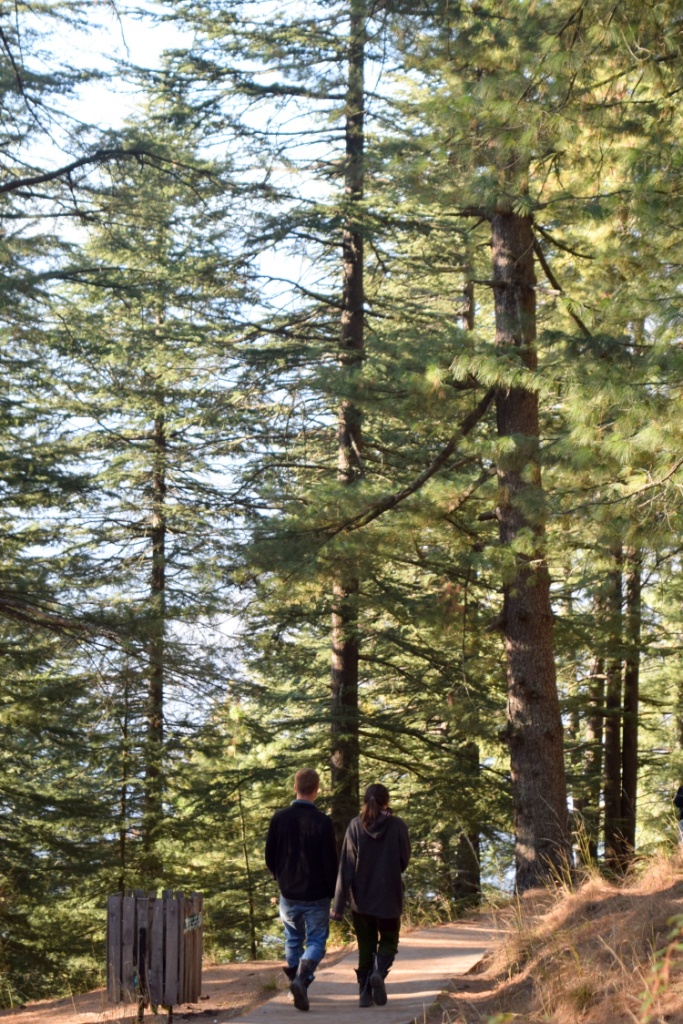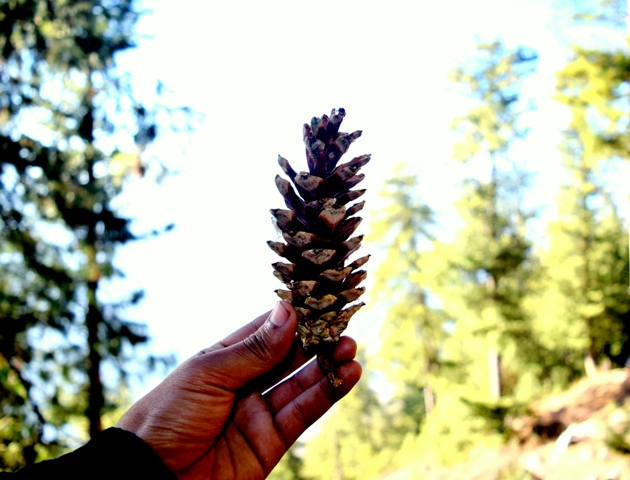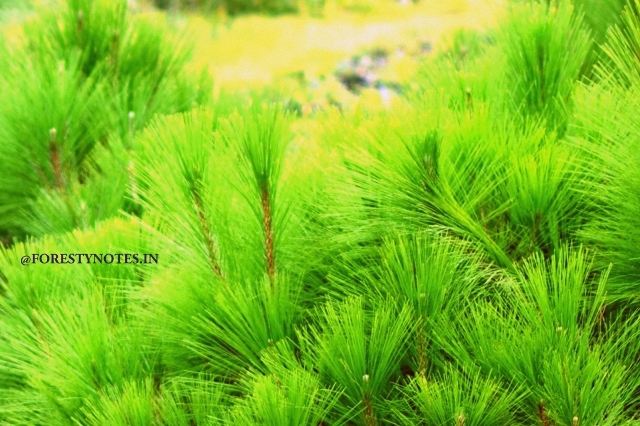Pinus roxburghii (Chir)-Silviculture of Pinus roxburghii
Pinus roxburghii
(Family : Coniferae - Pinaceae )
Synonym : P. longifolia
Local Names : Chir: Chil; Cheel
Trade Name : Chir pine
Distribution

Chir is found in the outer Himalayan ranges and on the ridges of Siwalik hills, from 900 - 1800 m elevation: occasionally descending down to 500 m and ascending upto 2200 m. It occurs extensively in Jammu, Himachal Pradesh (Kangra) and Uttarakhand (Garhwal and Kuman hills). It is a gregarious species, remarkably pure on quartzite. Towards its upper limit, it is found mixed with Kail, deodar and ban oak; and in its lower limits, sal, khair, Bauhinia. Ougeinia and other miscellaneous species occur with Chir. It is the most conspicuous and important constituent of Subtropical Himalayan Pine Forests.
Particulars about Seed:

Male flowers ripen and shed pollen from February to April; female flowers appear from early February onwards; pollination takes place from February to April; fertilization occurs during the second year. Ripe cones appear during April-May (sometimes March), open and shed seed in hot and dry weather; in cool localities, seed remains unshed till June. Dry cones remain on the tree for a year or longer. Fair seed year occurs every 2 - 3 years; a good seed year once in 4 or 5 years.
Cones are collected from healthy, tall, twist-free trees in March or April; or from trees felled during or after December, and stored till April; cones are then kept out in the sun to open, and seed is threshed or shaken out and cleaned. Seed is winged; number of seeds in each cone varies from 30 to 100, average being 40 - 50; seed weight varies from 8800 to 12500/kg. Seeds retain viability for over two years, if stored under proper conditions in sealed containers. Germinative capacity of fresh seed is 75 - 85%. Soaking of seed in water for 24 hours hastens germination.
Methods of Propagation
Natural Reproduction : In nature, seed falls April to June, germinates with break of rains. In a good seed year, regeneration profuse, provided the seed bearers are healthy and suitably spaced (about 0-25 m apart) and the area is protected against fire, grazing and careless grass cutting. Young seedlings are kept well weeded and cleaned for their proper establishment and growth.
Artificial Propagation: Direct sowing at the commencement o rains is quite easy and successful; this may be done in patches, or about contour lines.
Chir can also be successfully raised by planting out a year oh nursery-raised entire plants with ball of earth, or container plants polythene bags), in pits 30 cm³, dug in advance, spaced 2 m x m to 3 m x 3 m. This method is preferable, particularly in afforestation of degrades and heavily grazed hill slopes. Poorly drained soils should be avoided as the young plants damp off in excessively damp sites.
Nursery Practice:
Seed is treated with red lead before sowing in beds (to protect against pests), soon after collection; beds are irrigated regularly till break of rains Seedlings are pricked out in transplant beds. or into polythene bags during, the first rains; they are ready for planting out with ball of earth in the second rains when 14 - 15 months old. As an alternative, seed is sow directly in Polythene bags, 2 seeds in each, at the break of rains; singling out the seedlings if both germinate and planting these out in the following rainy season. Seedlings are watered and weeded regularly in the nursery.
Tending
Regular weedings are necessary, both in the nursery and a regeneration areas. Saplings are cleaned and spaced when about a meter in height. Chir is a strong light-demander; first thinning is done at the age of 15 years and subsequently repeated every ten years; C-grade ordinal thinning is usually prescribed. Young crop has to be protected against fire.
Injuries, Pests and Diseases :
Injuries : Birds, monkeys and flying squirrels damage seeds while still on the trees; monkeys. rats and porcupines cause excessive damage to young seedlings by nibbling their roots; birds bite off cotyledons of germinating seeds. Young plants damp off in poorly drained soils. Though Chir is fire-hardy. but still fires cause excessive damage, or even destruction, in Chir areas due to several pre-disposing factors; control burning in wiinter reduces the frequency and intensity of fires.
Grazing and grass cutting in young seedling crop are injurious. Twisted fibre. and inherited defect, badly impairs the utility and value of chir trees. Amongst the climbers, Rosa moschata is a serious menace in young crops.
Insects : Young seedlings are subject to various forms of insect damage. the most serious being caused by grass hoppers, which bite through the stems.
Fungi : Commonest fungus found on chir is Peridermium complanutum, which appears on the needles in the form of orange coloured sacs of spores, about April-June. Cronartium himalayanse is a rust disease of saplings, often killing them; Coleasporium companulue is a nedle rust of chir.
General
(1) Chir is a large evergreen tree, sometimes nearly deciduous in dry localities, in dry seasons; typically gregarious, forming even aged crops. Trees up to 54 m in height and 3 m in girth have been recorded in Tons Valley (Uttarakhand.).
Chir is a very strong light-demander; frost-hardy; wind-firm; sensitive to severe drought in early stages; though fire-hardy because of thick bark, yet suffers bedly from fire damage for other reasons.
(ii) Its timber is resinous; moderately heavy; strong; coarse-grained; sometimes spiral-grained. It is a general purpose timber, used in buildings, carpentry, flooring, joinery, poles, posts, etc. Untreated timber is not durable; when treated, it is used for Railway sleepers also. It gives quality charcoal which is preferred by blacksmiths.
(iii) Trees, when tapped, yield resin which on distillation gives rosin and turpentine, articles of great industrial importance. Chir is the main resin producing pine of India.
(iv) Its wood (even spiral grained) is a very useful long fibred pulpwood.
(v) Chir seed is eaten by local people.
(vi) Chir forests are generally worked under Uniform System on a rotation of 120 - 150 years, with a regeneration period of 30 years.


